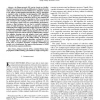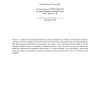298 search results - page 48 / 60 » Optimizing number of hidden neurons in neural networks |
CORR
2007
Springer
13 years 7 months ago
2007
Springer
Results of neural network learning are always subject to some variability, due to the sensitivity to initial conditions, to convergence to local minima, and, sometimes more dramat...
GECCO
2008
Springer
13 years 9 months ago
2008
Springer
One of the major difficulties when applying Multiobjective Evolutionary Algorithms (MOEA) to real world problems is the large number of objective function evaluations. Approximate...
IJCNN
2007
IEEE
14 years 2 months ago
2007
IEEE
— In the process of learning a pattern I, the Fuzzy ARTMAP algorithm templates (i.e., the weight vectors corresponding to nodes of its category representation layer) compete for ...
TNN
2010
13 years 2 months ago
2010
Abstract--An Elman network (EN) can be viewed as a feedforward (FF) neural network with an additional set of inputs from the context layer (feedback from the hidden layer). Therefo...
GECCO
2011
Springer
12 years 11 months ago
2011
Springer
—A number of representation schemes have been presented for use within Learning Classifier Systems, ranging from binary encodings to Neural Networks, and more recently Dynamical ...


